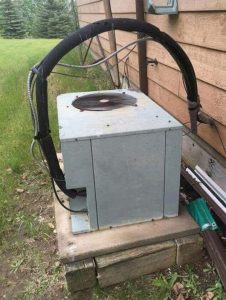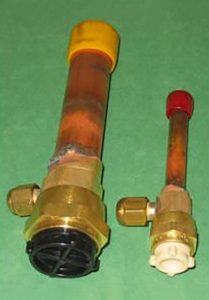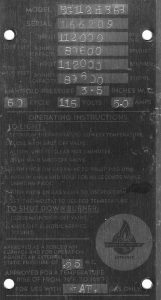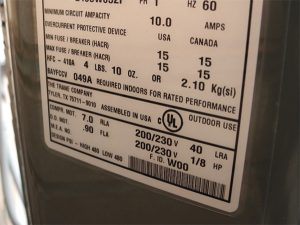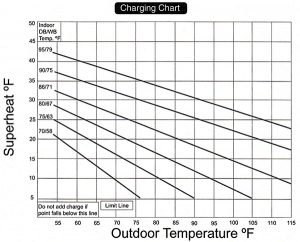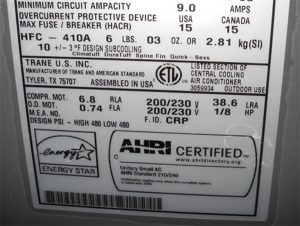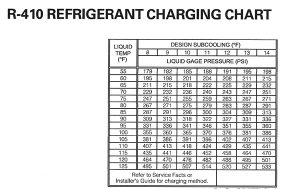
Are you overcharging cooling systems?
May 17, 2017 | By Ian McTeer
Every industry has its heroes, including HVAC/R. People such as Michael Faraday, Willis Carrier, Fredrick McKinley Jones and Thomas Midgley Jr. provided a large measure of inspiration for me as I progressed through the science of refrigeration and air conditioning. However, Thomas Midgley Jr. is one of those unfortunate people who goes from hero to zero and not necessarily because his contributions to the refrigeration industry have faded away into legislative purgatory.
Midgley, a brilliant chemist and mechanical engineer, led a team of coworkers in an effort to improve the synthesis of CFCs into a safer refrigerant. As an employee of GM, he helped the Frigidaire brand to become a household name using safer CFC 12 refrigerant instead of the toxic ammonia and sulphur dioxide used previously.
GM and DuPont formed Kinetic Chemicals in 1930 with Midgley’s team developing an entire class of chlorinated refrigerants including HCFC22. Midgley won many awards for his efforts. Given to theatrical demonstrations, Midgley would inhale a lung full of CFC12 and then blow out a candle with it showing no ill effects. Try doing that with ammonia. Not only useful for refrigeration and air conditioning applications, CFC11, CFC12, HCFC22 and several other chlorinated compounds were used as blowing agents, propellants, solvents and degreasing agents.
In the 1930s, no one could have guessed that chlorine based refrigerants would, one day, prove to be so harmful to Earth’s atmosphere.
Midgley’s reckless insistence on adding another one of his inventions, tetraethyl lead (TEL), to gasoline as an anti-knock compound ultimately ruined his legacy. Even though pure ethanol fuel with the advantage of naturally higher octane existed at the time, Midgley and GM pressed ahead with TEL. Midgley arranged a crazy demonstration purporting to prove the safety of his lead based fuel additive.
In front of reporters, he poured TEL over his hands then sniffed TEL from a beaker for 60 seconds, smiling all the while. What went unreported was Midgley’s yearlong leave of absence from GM to treat his lead poisoning. But TEL, somehow, prevailed. It took decades to finally get dangerous, polluting lead out of most motor fuels. Midgely developed polio late in life and died of strangulation at his own hand after he became entangled in a rope and pulley affair he developed to help others lift him in and out of bed. J.R. McNeill, an environmental historian, said Midgley, “had more impact on the atmosphere than any other single organism in Earth’s history.”
MEA CULPA
I had a horrible dream not long ago that as I “shuffled off this mortal coil” and descended into the depths of the ODP underworld, Midgley himself meets me on the banks of the river Styx. He waves around an open 14kg jug of HCFC22 over his head. I am then enveloped in a cloud of vapourizing Freon, coughing, choking and begging for mercy. “But Thomas, you told me to vent to the atmosphere, vent to the atmosphere.” I, along with just about every other mechanic in the industry, released refrigerants almost daily before scientists told us the bad news about the ozone layer. Decommissioning older systems meant “blowing the charge safely” to the atmosphere. As I became more proficient at service, there was one specific and very annoying reason for releasing refrigerants to the atmosphere that I encountered too many times and that was overcharging.
PRECHARGED SYSTEMS
In the late 1970s, as residential air conditioning became more affordable for many homeowners, a new type of cooling split system arrived on the market. The system featured an HCFC22 factory-charged outdoor unit, an evaporator coil with a holding charge of HCFC22 and a pre-charged HCFC22 line set used to connect the outdoor unit to the evaporator coil. For professional installers, the pre-charged systems proved to be very installation friendly because no deep vacuum of the system was required and factory sealed components added to overall reliability. Professional installers understood the pre-charged copper tubing needed to be handled carefully to avoid sharp bends causing kinked tubing.
They also knew how to route the tubing in such a way as to be aesthetically pleasing outdoors while avoiding oil traps caused by improper coiling of excess tubing. They knew to keep the protective caps tightly in-place on all the system components prior to installation thus preventing the entry of dirt or debris into the fittings that could cause a leaky connection.
Figure 1 illustrates a DIY project featuring a pre-charged line set installed by someone who might charitably be called a non-professional. I encountered such installations dozens of times. To make matters worse, the system access Schrader valves incorporated into the bolt-on fittings, were often rotated in a direction that prevented a refrigeration gauge hose from being connected. I often had to use a set of piercing valves to gain system access, but they often leaked over time. Sometimes, I could save the system by “blowing the charge” and cutting out all the excess copper. Then, I would refashion the line set by brazing-in the appropriate number of copper elbows, installing new tube insulation and reconnect to the unit using a stub kit (see Figure 2), making sure the Schrader valves were accessible.
Although pre-charged systems made installations easier, using them did not necessarily mean any particular split system was perfectly charged. Professional installers knew to check the charge at every start-up. In those days, evaporator coils used capillary tube metering, thus the only effective method of evaluating the charge was the superheat method.
Non-professional installers used the “beer-can cold” method. They would simply add HCFC22 to the system until the suction line felt beer-can cold. More often than not, pre-charged systems were already overcharged.
To make matters worse, many pre-charged systems were installed into air handling systems never designed for cooling. Very often, the existing furnace should have been changed and ductwork modified for cooling.
Overcharging, some quickly learned, prevented the evaporator coil from freezing long enough to get paid and leave the scene. I once heard someone say, “Add gas until you get 70 on the blue gauge.” The furnace rating plate in Figure 3 says it can deliver rated airflow at 0.25” w.c. where as the furnace in Figure 4 could be converted to high static operation (0.75” w.c.) by installing a 1/2HP motor and larger motor pulley. Non-professionals had no idea such changes were necessary, resulting in customer complaints about poor performance, failed compressors and, no doubt, tons of HCFC22 unnecessarily “vented to the atmosphere.” Refrigerant recovery became a requirement in 1987, but reports of intentional releases persisted for years.
THE SITUATION TODAY
Capillary tube refrigerant metering eventually gave way to a more efficient method utilizing a small piston with an appropriately drilled hole through it engineered for a specific application. Metering pistons have the benefit of reducing flash gas and can be used in cooling only or heat pump applications. Different sizes were developed for HCFC22 and HFC 410a refrigerants. There are still many AHRI rated outdoor unit and indoor coil combinations using HFC 410a refrigerant that can meet the 13 SEER minimum efficiency standards using a metering piston.
Today, as in the past, some technicians and others (the non-professionals) connect a gauge set to a poorly performing system and immediately want to add some gas because the suction pressure is low. Professionals will always check the air handling side first for airflow problems.
Remembering that refrigerant moves heat outside, cools the compressor windings and circulates oil to lubricate the compressor, proper charge is extremely important. An overcharge will reduce homeowner comfort because a flooded evaporator does not dehumidify. The system will be incapable of controlling sensible heat while needlessly consuming excess power as it runs for hours doing nothing good.
SUPERHEAT
Prevent overcharging by following manufacturers’ charging recommendations. Systems utilizing metering pistons are generally charged using superheat. Some manufacturers may provide a chart or table in the unit’s installation instructions. Typically, with the unit running under “normal” cooling conditions (with a clean air filter, clean blower wheel, appropriate heat load on the evaporator coil, correct CFM for the application and outdoor temperature above 68F) the system should have somewhere between 10F and 30F of superheat. A superheat approaching 5F indicates overcharge, a superheat approaching 40F indicates undercharge.
SUBCOOLING
Systems controlled by TXVs are charged by the subcooling method. The technician always needs to take accurate measurements that should be recorded for future reference regardless of metering device. This information is vital: dry bulb temperature of the air entering the outdoor coil; suction pressure; head pressure; suction line temperature; liquid line temperature; dry bulb and wet bulb temperature of the air entering the evaporator coil; and dry and wet bulb temperature of the air leaving the evaporator coil
I had an interesting experience at a demonstration of an infrared camera. The operator had taken a thermal image of a condensing unit on a rooftop; he really had no idea of what the image might show. I recognized that half the volume of the outdoor coil was dark blue indicating a massive overcharge. See the sidebar below for some tips on preventing overcharging.
TO DROP-IN OR NOT
Removing excess refrigerant from a system is something that should never be necessary. Other than for repairs or decommissioning, the proper charge should remain intact for the life of the system, barring mishaps leading to unintended leakage. Back in the day, I treated HCFC22 as a dependable tool. It was difficult to watch such a valuable component streaming off into the sky simply because someone failed to properly address the shortcomings of any particular system.
HCFC22 charged residential and commercial units will remain in service for many years. Chris Palmer, area manager at Trane Supply, tells me an adequate amount of virgin HCFC22 is available to all ODP card-carrying contractors across the country. I know the current wholesale price is 10 to 15 times more than I paid back in the 1980s. Even so, every contractor should have a policy for dealing with HCFC22 units needing additional refrigerant due to leaks or component replacement. If a leak develops and can be found and repaired easily, it benefits the customer to have a proper repair rather than suffer the cost of a system replacement.
News reports talk about some salespeople telling homeowners their air conditioners contain “illegal” refrigerant. Some contractors refuse to repair HCFC22 systems, preferring to change them out; some end-users will not be well served by such an attitude.
Leakers can be notoriously difficult to repair leading to exorbitant diagnostic times, not to mention potential payment disputes with customers. Leakers are a special case often justifying the installation of a new system including a properly-sized, leak-free line set.
Some contractors are eager to use “drop-in” refrigerants in place of virgin HCFC22. Drop-in refrigerant marketing claims I have read indicate all compressor manufacturers are on-board with drop-ins for HCFC22.
I would want to be certain that, in a warranty replacement situation, the compressor manufacturer and his agent approve of your plans to use alternative refrigerants. Replacing a burntout HCFC22 compressor and then adding a drop-in refrigerant along with a can of acid neutralizer is no guarantee the new compressor will be happy. Regardless of equipment manufacturer, service contractors must follow manufacturer’s instructions and industry guidelines.
IN THE END
Midgely’s refrigerants did serve us well, even though the ozone layer still has a significant headache. Ironically, many industry folks are very excited about the new generation of non-ozone depleting and zero GWP products coming onto the market. Each newbie has its own particular properties, but the words, “high pressure”, “toxic”, and “flammable” are floating around again, just like in Midgley’s time. One thing I am sure about: no one is going to take a lung full of R290 and then exhale it at a candle anytime soon.
Tips to prevent overcharging
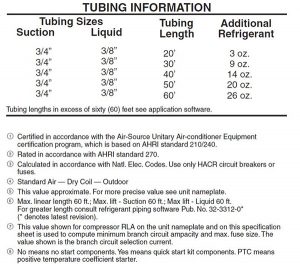 This manufacturer defines tubing size and additional refrigerant charge for line sets longer than 15 feet. The outdoor unit is charged for 15 feet of liquid line. In a recovery situation where the outdoor unit is empty, use the nameplate charge + additional charge for longer line sets.
This manufacturer defines tubing size and additional refrigerant charge for line sets longer than 15 feet. The outdoor unit is charged for 15 feet of liquid line. In a recovery situation where the outdoor unit is empty, use the nameplate charge + additional charge for longer line sets.
Notes: For AHRI rated combinations only. This chart is for a specific unit. Presented for information only.
Maximum line set length is 60 feet. Maximum lift is 60 feet (no traps allowed). Be sure to consult the manufacturers representative for advice if longer lengths are required.
This unit uses HFC410A: total outdoor unit charge including 15 feet of rated liquid line tubing is 4 pounds 10 ounces. The indoor coil has a #49 metering piston and must be charged using the superheat method. Check manufacturer’s literature for additional charge information.
In this example, the outdoor air temperature is 88F. The indoor temperature is 86F with a wet bulb at 71F. Enter the chart at 88F and draw a vertical line until it reaches the 86F curve. Draw a horizontal line to the left side and read the superheat at 19F.
This unit uses HFC410A: total outdoor unit charge including 15 feet of rated liquid line tubing is 6 pounds 3 ounces. The AHRI rated indoor coil must have a TXV metering device and must be charged using the subcooling method. Check manufacturer’s literature for additional charge information. Tubing length and vertical lift may affect the amount of subcooling required.
Your manufacturer may provide a chart like this for TXV charging. Measure the liquid line temperature after 15 minutes of system operation. Connect a head pressure gauge. If your system calls for 10F of subcooling and your thermometer is reading a liquid line temperature of 85F, read the “85” column to the right until it intersects with the 10F subcooling vertical column. Read gauge pressure at 296 psig.
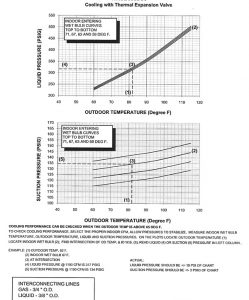 This manufacturer provides two charts for charge evaluation. Using four factors:
This manufacturer provides two charts for charge evaluation. Using four factors:
- Temperature of the air entering the outdoor coil (DB)
- Temperature of the air entering the indoor coil (WB)
- Head Pressure
- Suction Pressure
In this example, the ODT is 82F (DB). IDT is 67F (WB)
Enter each chart at 82F and draw a vertical line until the measured wet bulb temperature curve is reached.
Then read off directly to the left:
Under the measured conditions shown above, the head pressure should be 320 psig +/- 10 psig of chart
Suction pressure should be 135 psig +/- 3 psig of chart.
For example ONLY. Use your manufacturers charts for specific applications
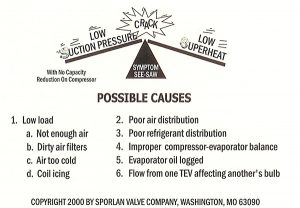 What to do when you cannot get your chart numbers. Suppose system subcooling is correct but you have got the dreaded low suction pressure and low to no superheat. Notice the #1 cause. Be sure to check the indoor section for Low Load. Do not be tempted to add more gas, you will only have to remove it later.
What to do when you cannot get your chart numbers. Suppose system subcooling is correct but you have got the dreaded low suction pressure and low to no superheat. Notice the #1 cause. Be sure to check the indoor section for Low Load. Do not be tempted to add more gas, you will only have to remove it later.
Ian McTeer is an HVAC consultant with 35 years experience in the industry. He was most recently a field rep for Trane Canada DSO. McTeer is a refrigeration mechanic and Class 1 Gas technician.

